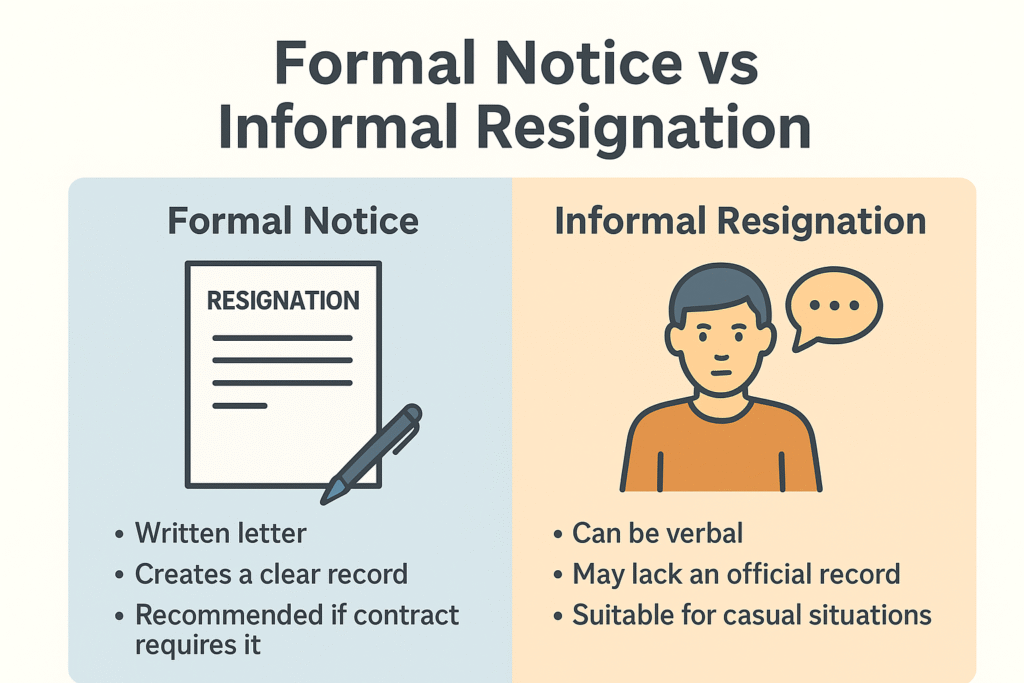Let me be blunt: handing in your notice is one of those small-but-heavy moments in your career. When you’re writing a resignation letter, if you do it well, you leave with dignity, a good reference, and bridges intact.
Do it badly, and you could make future networking awkward or lose access to helpful contacts.
If you are thinking of how to write a resignation letter later, this guide provides a friendly, practical roadmap, covering what to say and how to say it.
What is a Resignation Letter and Why is it Important?

Source: Statista
According to Statista, approximately 263,000 resignations occurred in the UK during the second quarter of the year. This indicates that job resignation is not uncommon and often occurs in the corporate world.
A resignation letter is a brief, formal note that informs your employer of your intention to leave. It’s not a speech, a rant, or an exhaustive explanation.
It confirms the date you handed in your notice, sets your final working day, and signals your intention to assist with the handover.
Many employers treat Writing a Resignation Letter as the official start of the exit process; others use it as a simple administrative record.
Because of that, it matters more than you might think: it becomes part of your employment file and may be relied on if there’s ever a dispute about notice or pay.
Beyond the legal and administrative function, a resignation letter is your last professional impression.
Formal notice vs informal resignation

There are two primary ways people often inform their employer of their intention to leave: verbally and in writing.
Verbal notice can be sufficient for a first conversation, but a written resignation creates a clear and accurate record. Many contracts require written notice.
It is also recommended that you write your notice if you need the evidence later. If your contract is silent, giving written notice is still a good idea, as it avoids “he said / she said” problems and protects you if anything goes wrong.
For standard cases, a short written letter, emailed or printed and signed, is the most effective approach.
Protecting professionalism and future references
Your future employers, colleagues, and industry contacts will likely judge your last impressions as much as your first ones.
A succinct, professional resignation letter helps preserve relationships and is the best way to change jobs. This also matters because networks often deliver opportunities years after you leave.
If you’re worried about burning a bridge, keep your letter factual and grateful and put difficult conversations in person or over a call rather than in writing.
If something legally serious is happening at work, ask for advice: sometimes a carefully worded letter is a necessary record, other times it can unintentionally harm a claim.
See Also:
Key elements to include in a resignation letter
The number of workforce jobs in the UK was estimated at 37.1 million in March 2025. Despite this, people continue to resign from one job to another, and it is essential to understand the key elements when writing a resignation letter.
When writing a resignation letter, keep it concise and professional. Date, addressee, a clear statement that you are resigning and your final working day
Add a brief note of thanks (if appropriate), and any practical offers to help with handover.
That’s it. Your aim is clarity because employers need to know precisely when your employment will end, how your holiday/notice will be handled, and whether you’re offering transitional support.
Avoid long explanations or complaints in the letter itself. Functional structure to follow:
- The opening statement (I hereby resign…)
- The last working day (based on your notice period or agreement),
- An offer to help with handover
- A thank-you note if it’s appropriate.
If you’re leaving because of a serious problem at work, maybe harassment, unsafe conditions, or other legal concerns, pause and get advice before you write the letter.
In those cases, an alternative route (e.g., raising a formal grievance first or seeking legal counsel) may be safer.
If something in your contract or staff handbook sets specific rules about resignations, follow them.
Date and recipient details
Start with the date and a clear addressee (line manager, HR director, or both). This is a simple detail that provides clarity if your exit becomes disputed later.
Address the letter to the person who manages your employment records: if that’s your manager and HR, include both. For example: “Dear [Manager’s name]”, then copy in HR on the email.
If you hand a printed letter to a manager, ask them to confirm receipt in writing. That short habit saves headaches; keep a copy for your records.
Statement of resignation and final working day
Say plainly that you are resigning and when your final day will be. If your contract requires one month’s notice, calculate the date and state it clearly. Or you and your manager agree on a different date, confirm that in writing.
Also, if you have a contractual or statutory notice obligation, include that detail so HR can manage payroll, holiday pay, and any garden-leave or payment-in-lieu arrangements. Keep the sentence short and specific.
Gratitude and professional tone
A brief sentence of thanks goes a long way. It doesn’t have to be effusive; a short acknowledgement of the opportunity or something positive you learned is enough.
This is about preserving relationships and making future conversations easier. Keep it sincere and brief; never fake it.
In case your time there wasn’t positive, save the deeper feedback for an exit interview (face-to-face) or a private conversation rather than the resignation letter.
Offer of transition support
Offer a short period of handover support, a summary of current projects, or train a replacement. If you can’t work your full notice, propose a plan: handover notes, documents, or a meeting to transfer knowledge.
Making this practical offer signals goodwill and professionalism, and it helps the employer plan, which reduces the risk of poor references.
If you and your employer agree on immediate release or payment in lieu of notice, get that in writing.
See Also:
Different types of resignation letters
Not all resignations are equal. Your circumstances determine the tone, length, and content of the letter. Below are the most common types and when to use each.
When you’re writing a resignation letter, choose the template that fits your situation: simple notice, notice with transition plan, immediate resignation, or reflective/thank-you resignation.
Pick the one that fits your story and use clear, professional language.
Short and simple resignation letter
This is the classic: one paragraph that states your resignation and final day, plus a sentence offering help with the transition. It works if you’re leaving on good terms and don’t need to explain your reasons.
It’s tidy and ensures the basics are covered, including date, final day, and a courteous closing. For most straightforward resignations, this is the safest route.
Resignation letter with notice period
Just like for probationary period where the employer give the employee, the notice period is the employee giving the employer time to look for a replacement.
If your contract sets a notice period, your letter should state it and the exact last working day. Contracts often specify notice terms, and statutory minimums apply if no contract terms exist.
If you’re in any doubt, check your written statement of employment particulars or the guidance on notice periods before you send the letter.
Clear dates avoid disputes and help HR process your final pay correctly. And the case where youare still seek for job, make sure you balance work and job search so that your handing over will not be affected.
Immediate resignation letter
Immediate resignations are rare and usually happen for urgent reasons (e.g., a new job with impossible start dates or serious workplace problems).
If you must leave immediately, explain briefly and factually, and offer to help where possible, but be aware that leaving without working your contractual notice can be a breach of contract unless there are exceptional circumstances.
If you believe you have legally valid grounds (constructive dismissal, serious breach by the employer), get advice before sending an immediate resignation.
Polite resignation letter with appreciation
If you’ve had a genuinely positive experience, this version lets you leave on a warm note.
Write a brief paragraph describing what you appreciated, like mentorship, training opportunities, a supportive team, and say you’ll stay connected.
These letters are great for networking and preserving long-term relationships. Keep it specific enough to be sincere, but short enough to remain professional and .
See Also:
Formatting tips for a professional resignation letter
A resignation letter should look tidy. Use standard business formatting: date at the top, recipient, a clear subject line (if emailing), short paragraphs, and a polite sign-off. Keep it to one page.
Use a readable font and avoid unusual formatting; this is an administrative document and should be easy to file and refer to later.
If you’re sending an email, use a clear subject line like: “Resignation ; [Your name]” and attach a signed letter if your employer prefers a printed version.
If your contract or staff handbook says to hand in a printed letter, do that, and give a scanned copy by email for records.
If you need to keep a record of delivery, use recorded delivery or request a confirmation email.
Length, tone, and structure
Keep your letter short; one page is normal. Use three to five short paragraphs: opening statement, final day, brief thanks, and offer to help. Keep sentences simple and clear.
Avoid a list of grievances in the letter. If you need to document workplace problems, do it in a separate, formal grievance or speak with HR and get advice. Your resignation letter should be forward-focused and practical.
Common mistakes to avoid when resigning
Don’t rant in writing, or make contractual promises you can’t keep (e.g., “I will train a replacement for three months” if you aren’t legally required to).
Please refrain from posting your resignation on social media before notifying your manager; it’s unprofessional and can create unnecessary friction.
Also, don’t forget to review your notice period and any contractual clauses regarding confidentiality, non-compete agreements, or garden leave provisions.
Email vs printed resignation letters
Email is a common and generally acceptable form of communication. It is also used to email hiring managers directly.
Attach a signed letter if required. Printed letters feel formal and are useful when you need a signature trail, but e-mail gives speed and an easy timestamp.
Always follow your contract and company policy, and keep copies of whatever you send. If the situation could be legally sensitive, a printed copy with proof of receipt may be wise.
See Also:
How to resign gracefully and maintain relationships
Leaving gracefully is a skill and this why you must learn how to write your resignation letter properly.
Tell your manager in person (or by video call if remote) before sending the formal letter, if you can.
Be prepared for a counteroffer or immediate questions about your final day and handover.
Keep your explanations short and honest, and keep emotions in check; These are basic office etiquette. If you’re resigning for a new role, a simple “I’ve accepted another opportunity” is enough.
Offer practical handover notes: project status, login information, key contacts, and priorities. Arrange a handover meeting and document outstanding tasks.
If you’re in a client-facing role, introduce your replacement (or a colleague) to clients. These practical gestures make transitions easier and preserve goodwill, and goodwill keeps your professional network intact.
Research shows a significant share of workers plan to look for new roles each year; being professional when you go helps when the job market circles back.
When and how to submit your letter
Ideally, tell your manager in person and then follow up with the written letter the same day. If you’re remote, tell them on a video call and then email the letter.
If you’re nervous about an immediate reaction, send the letter only after you’ve had the conversation, but don’t delay too long.
Keep a copy in your personal files and request a written acknowledgement.
Following up with an exit conversation
If your employer offers an exit interview, take it, but keep it constructive. Share feedback that could help the team, but avoid making it personal.
Use the exit interview to clarify final pay, outstanding holiday, references, and practicalities like returning equipment.
If you prefer not to do an exit interview, that’s okay too, but confirm in writing how final matters will be handled.
Leaving on good terms for future networking
A short, polite note and a tidy handover do more for your long-term prospects than a long, emotional explanation. Connect with colleagues on LinkedIn (if appropriate), thank those who mentored you, and keep channels open.
People remember professionalism and this can help you get hired faster if you are looking to pick up a new role. If you need a reference down the line, a clear record of a professional resignation helps.
Conclusion
If you’ve read this far, you now know the essentials of writing a resignation letter: be clear, be professional, and keep copies.

Before you hit send: check your contract for notice clauses, pick the template that matches your situation, tell your manager in person (if possible), and follow up with the written letter and a request for confirmation of receipt.
If your departure involves legal issues, or you are being laid off get advice before you send anything. For standard resignations, a short, polite, and practical letter will protect your reputation and help you leave on the best terms possible.
And if you are looking to land your next interview FAST, Applybuddy is your best bet. So, after you’ve handed in your resignation letter, don’t leave your next move to chance.
Head over to Applybuddy.co.uk today and take control of the next stage of your career journey with confidence.
FAQs
How much notice should I give when writing a resignation letter in the UK?
Check your contract first; the statutory minimum is one week after one month’s service.
Can I resign by email instead of a formal printed letter?
Yes. Email is usually acceptable; use a clear subject line, attach a signed copy if needed, and request written acknowledgement, unless the contract specifies printed notice.
What should I avoid writing in a resignation letter?
Avoid grievances, threats, accusations, or detailed complaints. Don’t promise unrealistic handover commitments.
Do I need to explain my reason for leaving in a resignation letter?
No. You don’t need to explain reasons. A brief neutral sentence suffices, e.g., “accepted another opportunity”.
